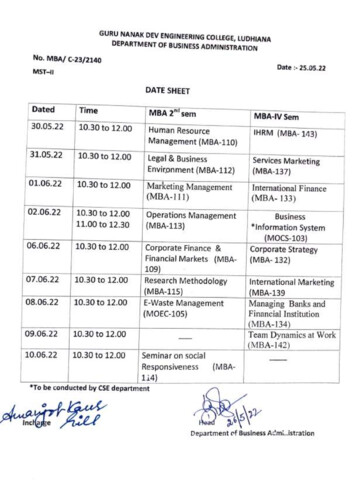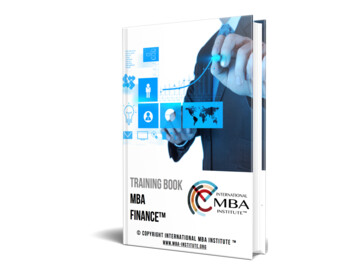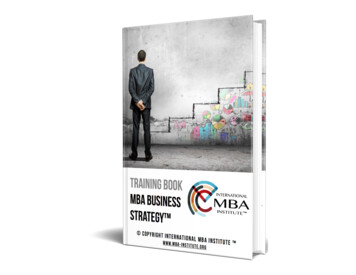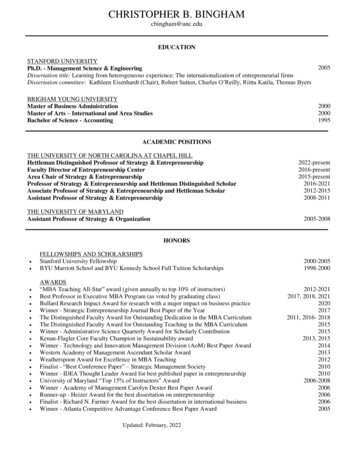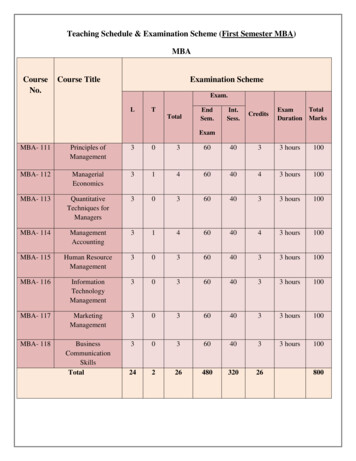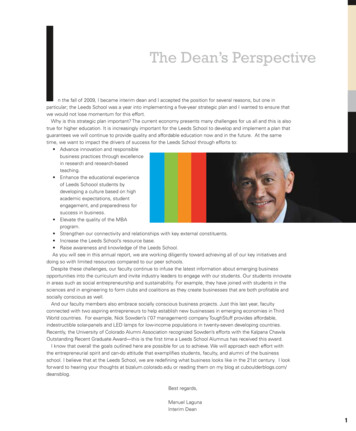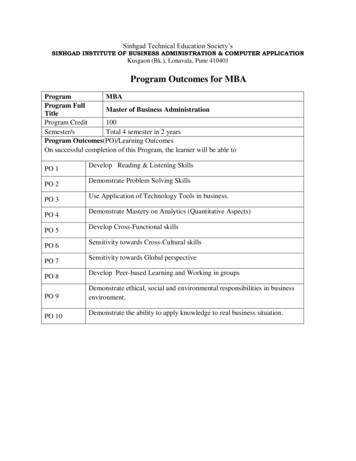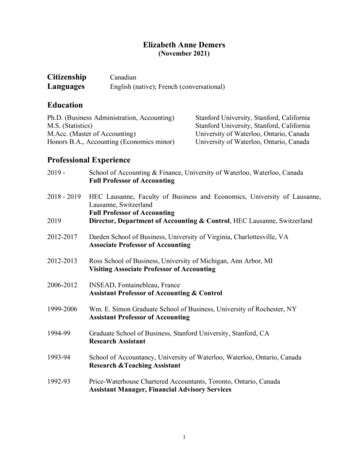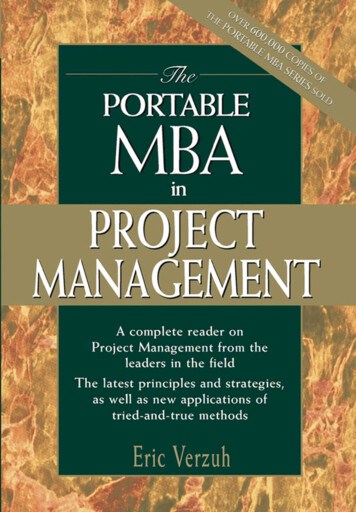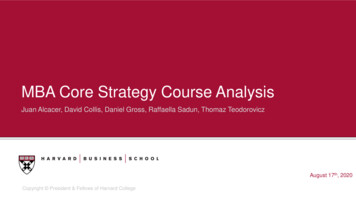
Transcription
MBA Core Strategy Course AnalysisJuan Alcacer, David Collis, Daniel Gross, Raffaella Sadun, Thomaz TeodoroviczAugust 17th, 2020Copyright President & Fellows of Harvard College
Objective To benchmark the core/quasi-core MBA strategy courses across top-ranked business schools in theUnited States and Europe This report summarizes the main findings All schools are anonymized and referred to as School 1, 2, 3, , 20. The order was generatedrandomly.2
Methodology Collection and analysis of syllabi (2019-2020 academic year) from 20 top business schools aroundthe world 17 business schools in the United States and 3 business schools in Europe Information on content, faculty/staffing, pedagogy, and reading materials 19 1-hour interviews with faculty in charge of course to Corroborate/clarify syllabus information Obtain quantitative course information Understand context of course (positioning in MBA program, staffing, strengths andweaknesses) Understand pedagogical approach Analysis and grouping of data in the following areas Context Faculty/Staffing Content Pedagogy/Grading3
Main Findings Timing: the core strategy course is often a stand-alone course available in the 1st semester (80%) asthe content is useful for internship interviews Courses have either one of two structures: marathon (several weeks with short sessions) or sprints(few weeks with long sessions) It is common for senior faculty to teach the course and to continue teaching it for long periods of time Relative homogeneity in the topics covered but heterogeneity in how topics are covered Most schools (14 3) follow classic tradition and/or value-based strategy Focus on core theoretical concepts of competitive strategy (e.g. price/cost strategies,alignment, 5 forces, and alike) discussed verbally and through cases 3 of these schools have idiosyncrasies briefed in the report Other schools (3) adopt an economic-driven course Focus on game theory models of dynamic interaction (e.g. models of entry, price wars,and alike) or on formal economic models about competitive strategy (e.g. Hoteling modelof diversification) Most schools use a mix of case method and lectures4
CONTEXT5
Status of strategy course in the MBA curriculumCourse type within MBA curriculum20.0% Change of core status toquasi-core (if any) is oftenimposed by school Core: mandatory to all fulltime MBA students Quasi-core: within a selectedset of “menu” of courseswhich students must choosesome from80.0% Even quasi-core courses arepopular amongst studentsQuasi-core6Core Enrollment rates between 60and 75% of the cohort
Timing of the main strategy course50%78%22%50% Why does it concentrate in the 1st semester? 7Course covers concepts that will be important for internship interviews
Position of other courses in relation to mainstrategy courseLarge variation in ics21602Finance I41420Accounting51410Business Analytics41411Marketing41060OB71030Operations reneurship02018taught before and afterstrategy due to:(1) variation in when strategyis taught; and(2) variation in the structure ofthe MBA programTechnical courses are taughtconcurrently with strategyStrategy is often the onlycase-based course in thesemester in which it is taughtNo evidence of coordinationacross courses
Schools vary in the length of the strategy course interms of weeks and in sessionsCourse length in weeksSchool 1School 2School 3School 4School 5School 6School 7School 8School 9School 10School 11School 12School 13School 14School 15School 16School 17School 18School 19School 20AverageSchool 1School 2School 3School 4School 5School 6School 7School 8School 9School 10School 11School 12School 13School 14School 15School 16School 17School 18School 19School 9Course length in .5051015Sessions2025
Strategy courses can be “marathons” (extensive)or “sprints” (intensive)11
Context: other notes Most schools reported having experiences low student-evaluations in theirrecent past that led to a revamp in the course Revamps punctuate periods of long stability with no changes in facultyand modest changes in topics12
Summary of context Strategy is mostly taught as a core course in 1st semester, often concurrentlywith technical courses that do not use cases No reported overlap with other courses Two types of strategy courses: Sprints: long sessions in fewer weeks (most courses) Marathons: short sessions spread over many weeks13
FACULTY/STAFFING14
Staffing – More seniors, less juniors In all schools but one, there is at least one senior faculty member teaching thecore class In 10 schools, out of 19 interviewed, all teaching faculty are seniors Only 4 schools assign juniors automatically to core strategy Most schools place juniors in undergrad course, part-time MBA course or electiveOnly these 4 schools have a process to rotate faculty in and out of the core class Only 3 schools reported to have some form of course head across sectionstaught; most schools have only an informal coordination15
Staffing – other notes Often the faculty teaching the core class do so for a long time Schools reported having senior faculty teaching the same course for between 10and 14 years When juniors start teaching the course, schools eventually report having somementoring process, though often informally 8 out of 19 schools use teaching assistants Schools rarely report formal coordination across faculty teaching differentsections of the same course16
Instructors typically teach 2 sections at a time18Faculty load: annual sections x number of faculty teaching1416 Higher faculty leverageabove that line, lowerfaculty leverage belowthat line24Number of sections6810 12School 14School 19School 11School 5School 4 Tradeoff betweenteaching multiple timesfor the same course forshort period of time vs.teaching once for a longperiod of timeSchool 20AverageSchools2 and 10School 17School 6Schools3 and 18Schools 7, 8, 9,12, and 16School 130School 101712345Number of faculty6789
Faculty load also varies in terms of time andstudents4500Faculty load per time and per students The figure does notadjust for time spent inpreparing the classes orspent in elective coursesMinutes per faculty (across all sections)3000350040002500School 2School 13School 20School 17School 9School 7School 3School 6 Most schools stay closeto the meanAveragec Schools 11 and 18School 8School 10School 16School 4School 19School 52000Lower loadSchool 15018Higher loadSchool 14100School 12150200Students per faculty (across all sections)250300
CONTENT20
What we did Characterize courses in multiple dimensions: Overall framing: HBS classic (Porter, Ghemawat, Collis/Montgomery, Rivkin)Value-based strategy (Brandenburger/Stuart)Resource-based view (RBV) (Barney, Wernerfelt, Prahalad/Hamel)Economics (Spulber, Besanko, Cabral, Saloner)Behavioral strategy (Gavetti, Fang) Topic analysis: Coverage of topic per school (extensive margin)Time intensity per topic (intensive margin)Clustering/Grouping of schools based on topic coverage Quantitative and formal orientation: 21Use of numerical evidence to sustain case-discussionUse of formal models to explain concepts
Five frameworks are often used to teach strategy Classic Strategy Value-based strategy E.g.: Spulber, Besanko, Cabral, SalonerBehavioral strategy 22E.g.: Barney, Wernerfelt, Prahalad/HamelEconomics E.g.: Brandenburger/StuartResource-based view E.g.: Porter, Ghemawat, Collis/Montgomery, RivkinE.g.: Gavetti, Fang
Most schools follow a mix of approachesSchool 1School 2School 3School 4School 5School 6School 7School 8School 9School 10School 11School 12School 13School 14School 15School 16School 17School 18School 19School 2023ClassicStrategyValue-basedstrategy RBVEconomicsBehavioralStrategy - Checkmarks mean the intensity of eachapproach within the course syllabus Value-based strategy is the most commonframework Often it supersedes traditional classic HBSview Industry analysis is minimized in at least 2schools 4 schools use economics to complement andsupport Classic HBS and Value-based strategy Collis/Montgomery is still predominant framingfor corporate strategy- Strategy is often a “stand-alone” course thatdiscusses its own concepts without necessarilyconnecting them to a larger set of fields inmanagement (rather than “integrative” coursethat connects management fields)
Classifying course sessions into strategy topics Started with common labels in syllabi Numerous trials of applying classificationto existing syllabi Consulted with colleagues and receivedfeedback Harmonized a refined version of thelabels Two independent raters evaluated eachsyllabus and classified sectionsaccording to their main topics Differences between classificationsresolved through discussions andinterviews24 Value Based StrategyIndustry Analysis/External ForcesResources/Dynamic CapabilitiesProduct DifferentiationCost AdvantageAlignmentNetwork -Market StrategyStrategy ImplementationStrategy DesignSustainability/Change/GrowthCompetitive DynamicsHorizontal DiversificationVertical DiversificationGeographic DiversificationStructure/GovernanceIncentive SystemsMicroeconomicsContextually-driven topicsOthers- Introduction/summary/exam/presentation
The most popular topics are still within competitivestrategy Graph shows the count of schoolswith at least one session about thetopic Industry analysis, cost advantage andproduct differentiation still mostcommon topics Large divergence on how toincorporate topics such asecosystems, platforms, networks Innovation/Technology topics mostlycovered through phenomenon-drivensessions25
The most time is spent on topics within competitivestrategyAverage % of time spent on topicCompetitive DynamicsIndustry AnalysisProduct DifferentiationContextual TopicsCost AdvantageValue-Based StrategyVertical DiversificationHorizontal DiversificationSustainability/ Change/ GrowthStrategy DesignNetwork rces/CapabilitiesGovernance StructureOtherGeographic DiversificationAlignmentStrategy ImplementationEntrepreneurshipNon-Market StrategyIncentive 32.22.12.11.81.71.10.90.8051015% of course time (w/o considering introduction/evaluation/simulations)26 Course time is, on average, dividedacross 10 topics Competitive dynamics is skewed byone school that uses 50% of thecourse to cover the topic Several “sub-topics”: Entry,Exit, Price Wars, etc. Nonetheless, 12 schools stillcover competitive dynamics Schools diversify in terms of othertopics This figure assumes that sessionswith multiple “core” topics divide theirtime equally across topics
Schools vary in their pace in covering topics220Average pace per topicSession length (minutes)100140180School 11School 17School 6School 13School 2School 7School 8School 9AverageSchool 12School 1960School 5School 14 School 1School 20School 16 School 3School 4School 15School 18School 101271.522.5Number of sessions for the average covered topic3
Schools vary in their orientation when coveringtopics Schools witheconomics-trainedfaculty favor a higherformal orientationFormal Orientation(use of formal models)HIGHLOWSchool 9School 11School 8School 10 No clear driver ofquantitativeorientationSchool 20School 3 Anecdotal evidencethat faculty would likemore quantitativelydriven cases Two schoolsreportedsupplying theirown quantitativematerialsSchool 18School 16School 19 School 6School 17School 4School 12School 2School 13 School 14School 1School 5School 7LOW28Quantitative orientation(e.g. use of financial indicators,support arguments with data)HIGH
Similarity of topics across strategy courses: highoverall Schools 9, 10, and 14 are the mostdissimilar for different reasons: School 9’s course is heavilyecon-based focused oncompetitive dynamics and gametheory School 10’s course is heavilyecon-based and a mix ofmicroeconomics/IO and strategy School 14’s course emphasizesstrategy design andimplementation Formal models about productdifferentiation, cost advantage, andcompetitive dynamics appear in afew schools where the faculty’sbackground is mostly economicsMeasure: pairwise Euclidean similarity comparing vectors of share of course time spent on each topic.29
Clusters: classic-strategy schools (14 3) andeconomics-based strategy schools (3)Hierarchical clustering of schools by composition of course(similarity in share of course dedicated to topics)(Dis)similarity measure: EuclidenClustering method: weighted average linkage 3 classic but with differentparadigmsSchool 14School 8School 20School 12School 17School 16School 13School 7School 1School 18School 5School 3School 15School 6School 4School 2School 19School 10School 11School 9030 14 schools aligned aroundclassic HBS and value-basedstrategy (and RBV) School 14: innovative pedagogy,focus on strategy design andimplementation School 8: strong formalorientation and 100% valuebased School 20: blend of manystrategy ideas, with someemphasis on value-based andeconomics.1.2.3Euclidean dissimilarity measure.4.5 3 heavily econ-driven schools(schools 9, 10, 11)
Summary of Content Although there are not striking differences in topics coveredacross schools, there are important differences in depth Strategy is often a stand-alone, self-contained, course withoutclear connection with other MBA courses Most schools distribute time across topics relatively evenly, andthe average topic is covered by something between 1 and 2sessions for all but one school Schools vary in terms of their pace Sprint through topics x deepen topics Few schools go through formal models More are starting to emphasize quantitative debates (e.g. relianceon financial indicators)31
PEDAGOGY32
Traditional cases are most popular course materialPooled number of readings in syllabi (across 20 schools)Book Cases are notupgraded often.8Research Article 11Other/Undefined33Note Non-case materialsare upgraded moreoften48Specialized Media53Book chapter56 General Media165Case19703350Average caseyear: 2008100Number of pieces150200Average year ofnews articles:2012
However, the intensity of case-use varies acrossschools22.5Intensity of case use by course lengthSchool 19Schools 2, 7, and 13Cases per week11.5School 4School 12School 9Schools 16 and 18School 5AverageSchool 11Schools 3, 6, and 14School 171.5School 20School 10School 80School 154345678910Course length in weeks11121314
Schools are increasingly using press articles as“mini-cases”Numbers of articles from general media in syllabusSchool 1School 2School 3School 4School 5School 6School 7School 8School 9School 10School 11School 12School 13School 14School 15School 16School 17School 18School 19School 20Average105080010291002928010818.30352040Number of pieces6080 Why? Complement/updatean existing case Substitute for a case Articles are oftenused to cover topicswithout good cases,such as platforms,ecosystems, networkeffects Articles as examplesof concepts
Cases and news articles (case-like materials)constitute most of the teaching materialsConceptual material: No textbook is widely accepted Apart from Brandenburger (most popularbook), most books are textbooks in theeconomics of organizations (e.g.Besanko et al) Most popular source of conceptualmaterials is magazine articles (e.g. HBR,MIT Sloan) “What is strategy” by Porter is mostpopular article Increasing number of school-specificmaterial36
On average, sessions are a mix of case-baseddiscussion and conceptual exposition% case discussion in typical sessionSchool 1School 2School 3School 4School 5School 6School 7School 8School 9School 10School 11School 12School 13School 14School 15School 16School 17School 18School 19School 20AverageLower case-led discussionassociated with eitherformal orientation (3schools) or longer classsessions (2 schools) We did not have informationabout school 15 How many conceptualslides per 8947037 204060%ofclass% of class minutes80100 13 slides on average Large variation: Some schools with 010; other schools with20 slides
Grading and pedagogical tools vary across schools Large variation in what is graded On average, 5 evaluation formats (max 7, min 2) Large diversity of exam formats Case-based exams are seldom used. Combination of small vignettes and conceptualquestions in different formats (multiple choice, free response questions). On average, 24% of final grade is associated with groupwork (e.g. group projects, simulations) Only two schools do not have a team-work activity composing the final grade Majority of schools have some version of experiential learning Most common type of experiential learning: group projects Only 4 schools do not have a team project Six schools have simulation as pedagogical tool; five of these use it in the final grade On average, 8% of the sessions are not used for case-discussion or lectures (i.e. for simulations,exams, and presentations).38
Summary of Pedagogy Although case-led discussion is still the backbone of strategy classes,there are three relevant trends Schools rely either on HBS cases or, more recently, on own cases Schools are using news articles in addition to and instead of traditionalcases in discussion-led sessions Most schools are using other tools to teach strategy, especiallyexperiential learning to illustrate strategy design and implementation Few schools rely intensively on case-method teaching Often, schools complement cases with Lectures to cover concepts “Mini-cases” (newspaper articles) Almost no exam is entirely case-based Team activities and/or experiential learning are used in 70% of coursesand included in students’ grade39
MBA Core Strategy Course AnalysisJuan Alcacer, David Collis, Daniel Gross, Raffaella Sadun, Thomaz TeodoroviczCopyright President & Fellows of Harvard College
Status of strategy course in the MBA curriculum 6 20.0% 80.0% Quasi -core Core Course type wi thin MBA curriculum Change of core status to quasi-core (if any) is often imposed by school Core: mandatory to all full-time MBA students Quasi-core: within a selected set of "menu" of courses which students must choose some from
